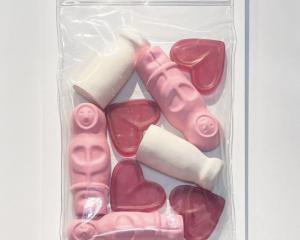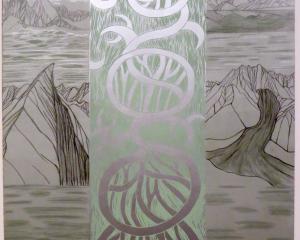"Art in Law VI." Various artists (Faculty of Law, Richardson Building, Otago University.)
In a variety of sizes, the works provoke contemplation, recollection and speculation; sentiments which are conceivably heightened by the department in which they are situated.
Particularly striking are Jo Robertson's two untitled sketches. Using graphite to depict the human form, the artist has given life to paper with conviction. Large and openly worked, her raw lines and dramatic tonal range haunt the surrounding hallways with psychological apprehension.
Desi Liversage's sequence of stitched blankets stress the bureaucracy of life's basic needs, and here, serve to exemplify the range of media on show.
Alternatively, Anya Sinclair's painting Wayland Woods (which invokes the visible brushwork of Europe's cherished impressionists) hints at the diversity of influences behind the exhibition.
From Lyn Taylor's historically inspired and meticulously composed prints of tawny hues to Vicki Urquart's sympathetically rendered portrait series - portrayals which transmit a modern honesty akin to that explored by Rita Angus or Robin White - the artistry continues to make an impression.
Kluster****. Sam Ovens, Nathan Forbes and Ant Scarer. (A Gallery).
This is commendable, however, since these astute Dunedin artists demonstrate insight and wit rather than prosaic discontent disguised as rebellion.
Ovens uses the pop aesthetic to express socio-political commentaries. The audacious, commercial colours deliberately demoralise his subject-matter, while the gestures, text and humour keep us fixated.
We Are Devoid is a sprightly print which appropriates the "Energy Dome" trademark of subversive band Devo with the parliamentary Beehive, so as to (somehow charmingly) debase our ostensibly "devolving" politicians.
Forbes, a second-year art student, uses clarity of form and immaculate brushwork to describe Lynchian horror scenes.
His narrative compositions cleanly describe an immensely disturbing part of human potential; the threat of brutal, instinctual violence from the minds of superficially prototypical children. Chucky meets The Shining in these challenging, yet disconcertingly appealing pieces.
Screaming inaudibly in the corner, Scarer has disgorged the mind of a graphic artist on multiple pieces of A4 paper. Fearsome and comical, these images of corpses, skulls, vamps and cars engage the eye with quick, descriptive lines which, when accumulated, form masses of animated details.
Rambunctious and original, the artist's forceful "ramblings" lash the room with cheeky quips.
Resisting Africa, Victoria Bell (Temple Gallery)
Resisting Africa is inspired by Bell's experiences of travelling through Africa as a tourist.
It addresses the notion of the cultural "other" and expresses the way that tourism, Western consumer culture and film have conjured a romantically "wild" and "dangerous" Africa, which might be experienced - if not in an air-conditioned Jeep - from one's own living room in the form of abstracted token mementos.
She juxtaposes Victorian furniture with safari souvenirs to epitomise how one culture can project itself upon another, assigning its own definitions and cultural understandings in the process.
On the floor, a lavish floral rug imitates a zebra skin, a statement on the animal hide as a cruel trophy, while above, a chandelier made of white satin flamingos (reminiscent of cushions) deals with the extravagance of "campaign furniture".
This is a demanding display, because the surreal, Lewis Carroll-esque aesthetic is fantastically seductive, but the ethics and questions it raises are manifestly grim.
- Franky Strachan







![Untitled (c. mid 1990s, [pink 3]), by Martin Thompson, 415mm×590mm. Photo: courtesy of Brett...](https://www.odt.co.nz/sites/default/files/styles/odt_landscape_small_related_stories/public/story/2024/02/untitled_pink_3.jpg?itok=Q0aQrc9o)




